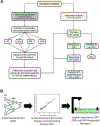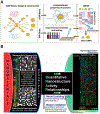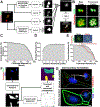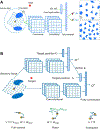Could artificial intelligence revolutionize the development of nanovectors for gene therapy and mRNA vaccines?
- PMID: 37034382
- PMCID: PMC10081506
- DOI: 10.1016/j.nantod.2022.101665
Could artificial intelligence revolutionize the development of nanovectors for gene therapy and mRNA vaccines?
Abstract
Gene therapy enables the introduction of nucleic acids like DNA and RNA into host cells, and is expected to revolutionize the treatment of a wide range of diseases. This growth has been further accelerated by the discovery of CRISPR/Cas technology, which allows accurate genomic editing in a broad range of cells and organisms in vitro and in vivo. Despite many advances in gene delivery and the development of various viral and non-viral gene delivery vectors, the lack of highly efficient non-viral systems with low cellular toxicity remains a challenge. The application of cutting-edge technologies such as artificial intelligence (AI) has great potential to find new paradigms to solve this issue. Herein, we review AI and its major subfields including machine learning (ML), neural networks (NNs), expert systems, deep learning (DL), computer vision and robotics. We discuss the potential of AI-based models and algorithms in the design of targeted gene delivery vehicles capable of crossing extracellular and intracellular barriers by viral mimicry strategies. We finally discuss the role of AI in improving the function of CRISPR/Cas systems, developing novel nanobots, and mRNA vaccine carriers.
Keywords: AI; CRISPR/Cas; gene delivery vehicles; gene therapy; mRNA vaccine carriers; nanobots.
Conflict of interest statement
Declaration of Competing Interest The authors declare that they have no known competing financial interests or personal relationships that could have appeared to influence the work reported in this paper. Conflicts of interest MRH declares the following potential conflicts of interest. Scientific Advisory Boards: Transdermal Cap Inc, Cleveland, OH; Hologenix Inc. Santa Monica, CA; Vielight, Toronto, Canada; JOOVV Inc, Minneapolis-St. Paul MN; Consulting; USHIO Corp, Japan; Sanofi-Aventis Deutschland GmbH, Frankfurt am Main, Germany. Stockholding: Niraxx Light Therapeutics, Inc, Irvine CA; JelikaLite Corp, New York NY.
Figures









Similar articles
-
Prediction of off-target specificity and cell-specific fitness of CRISPR-Cas System using attention boosted deep learning and network-based gene feature.PLoS Comput Biol. 2019 Oct 28;15(10):e1007480. doi: 10.1371/journal.pcbi.1007480. eCollection 2019 Oct. PLoS Comput Biol. 2019. PMID: 31658261 Free PMC article.
-
Delivery Aspects of CRISPR/Cas for in Vivo Genome Editing.Acc Chem Res. 2019 Jun 18;52(6):1555-1564. doi: 10.1021/acs.accounts.9b00106. Epub 2019 May 17. Acc Chem Res. 2019. PMID: 31099553 Free PMC article.
-
An overview: CRISPR/Cas-based gene editing for viral vaccine development.Expert Rev Vaccines. 2022 Nov;21(11):1581-1593. doi: 10.1080/14760584.2022.2112952. Epub 2022 Sep 6. Expert Rev Vaccines. 2022. PMID: 35959589 Review.
-
The Synergy between CRISPR and Chemical Engineering.Curr Gene Ther. 2019;19(3):147-171. doi: 10.2174/1566523219666190701100556. Curr Gene Ther. 2019. PMID: 31267870 Review.
-
Artificial Intelligence in Urooncology: What We Have and What We Expect.Cancers (Basel). 2023 Aug 26;15(17):4282. doi: 10.3390/cancers15174282. Cancers (Basel). 2023. PMID: 37686558 Free PMC article. Review.
Cited by
-
Strategies for enhanced gene delivery to the central nervous system.Nanoscale Adv. 2024 Apr 25;6(12):3009-3028. doi: 10.1039/d3na01125a. eCollection 2024 Jun 11. Nanoscale Adv. 2024. PMID: 38868835 Free PMC article. Review.
-
Mapping the landscape of AI and ML in vaccine innovation: A bibliometric study.Hum Vaccin Immunother. 2025 Dec;21(1):2501358. doi: 10.1080/21645515.2025.2501358. Epub 2025 May 16. Hum Vaccin Immunother. 2025. PMID: 40376848 Free PMC article.
-
Developing mRNA Nanomedicines with Advanced Targeting Functions.Nanomicro Lett. 2025 Feb 21;17(1):155. doi: 10.1007/s40820-025-01665-9. Nanomicro Lett. 2025. PMID: 39979495 Free PMC article. Review.
-
RNA Nanomedicine: Delivery Strategies and Applications.AAPS J. 2023 Oct 2;25(6):95. doi: 10.1208/s12248-023-00860-z. AAPS J. 2023. PMID: 37784005 Review.
-
Transitioning from wet lab to artificial intelligence: a systematic review of AI predictors in CRISPR.J Transl Med. 2025 Feb 4;23(1):153. doi: 10.1186/s12967-024-06013-w. J Transl Med. 2025. PMID: 39905452 Free PMC article.
References
-
- Somia N, Verma IM. Gene therapy: trials and tribulations. Nature Reviews Genetics. 2000;1(2):91–9. - PubMed
-
- Cavazzana-Calvo M, Thrasher A, Mavilio F. The future of gene therapy. Nature. 2004;427(6977):779–81. - PubMed
-
- Dunbar CE, High KA, Joung JK, Kohn DB, Ozawa K, Sadelain M. Gene therapy comes of age. Science. 2018;359(6372):eaan4672. - PubMed
-
- Mulligan RC. The basic science of gene therapy. Science. 1993;260(5110):926–32. - PubMed
-
- Verma IM, Naldini L, Kafri T, Miyoshi H, Takahashi M, Blömer U, et al. Gene therapy: promises, problems and prospects. Genes and resistance to disease: Springer; 2000. p. 147–57.
Grants and funding
LinkOut - more resources
Full Text Sources
